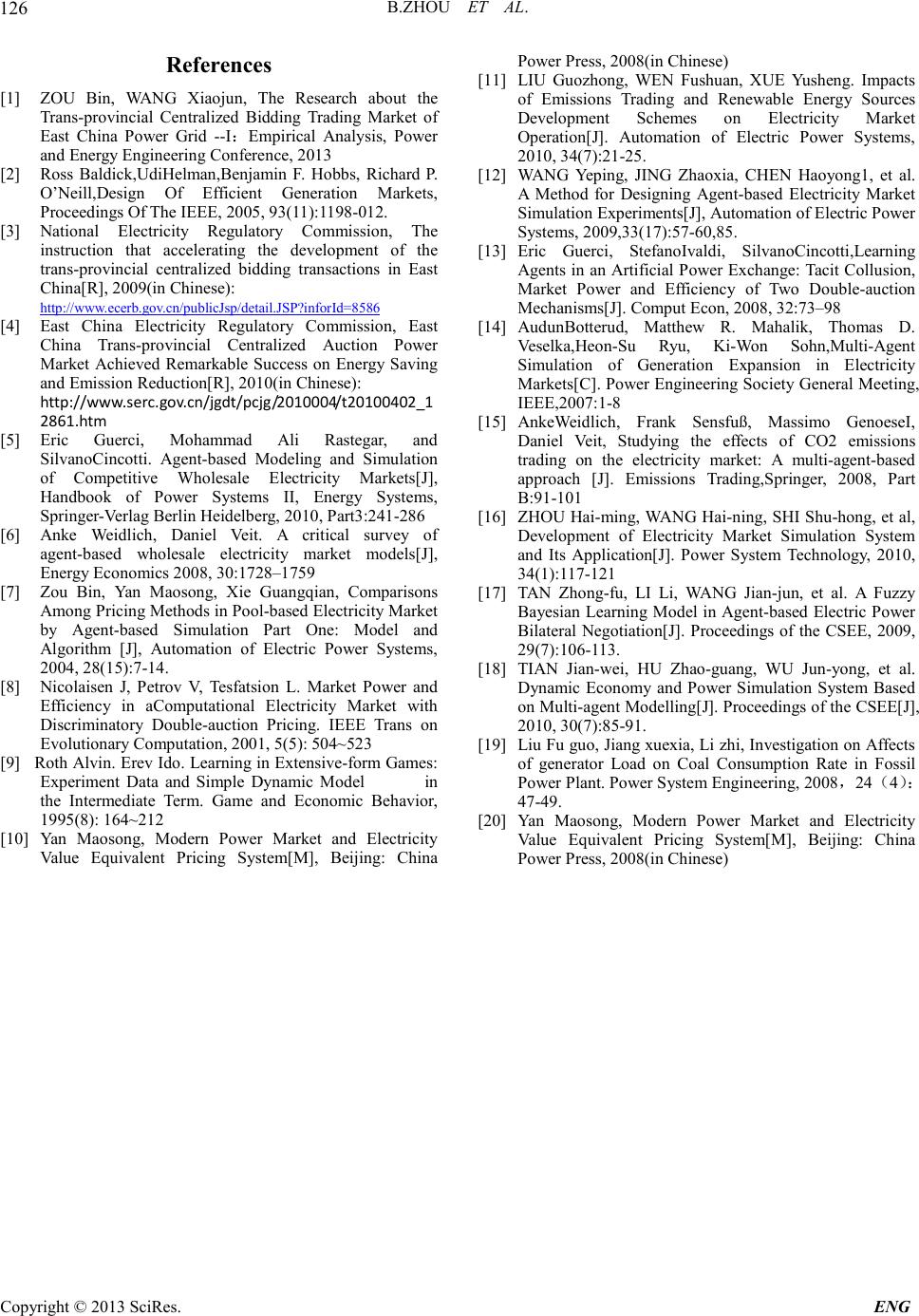
B.ZHOU ET AL.
Copyright © 2013 SciRes. ENG
Referen ces
[1] ZOU Bin, WANG Xiaojun, The Research about the
Trans-provincial Centralized Bidding Trading Market of
East China Power Grid --I:Empirical Analysis, Power
and Energy Engineering Conference, 2013
[2] Ross Baldick,UdiHelman,Benjamin F. Hobbs, Richard P.
O’Neill,Design Of Efficient Generation Markets,
Proceedings Of The IEEE , 2005, 93(11):1198-012.
[3] National Electricity Regulatory Commission, The
instruction that accelerating the development of the
trans-provincial centralized bidding transactions in East
China[R], 2009(in Chine s e ) :
http://www.ecerb.gov.cn/publicJsp/detail.JSP?inforId=8586
[4] East China Electricity Regulatory Commission, East
China Trans-provincial Centralized Auction Power
Market Achieved Remarkable Success on Energy Saving
and Emission Reduction[R], 20 10 ( i n Chi ne s e ) :
http://www.serc.gov.cn/jgdt/pcjg/2010004/t20100402_1
2861.htm
[5] Eric Guerci, Mohammad Ali Rastegar, and
SilvanoCincotti. Agent-based Modeling and Simulation
of Competitive Wholesale Electricity Markets[J],
Handbook of Power Systems II, Energy Systems,
Springer-Verlag Ber lin Heidelberg, 2010, Part3:241-286
[6] Anke Weidlich, Daniel Veit. A critical survey of
agent-based wholesale electricity market models[J],
Energy Economics 2008, 30:1728–1759
[7] Zou Bin, Yan Maosong, Xie Guangqian, Comparisons
Among Pricing Methods in Pool-based El ectrici ty Mar ket
by Agent-based Simulation Part One: Model and
Algorithm [J], Automation of Electric Power Systems,
2004, 28 ( 15 ) :7-14.
[8] Nicolaisen J, Petrov V, Tesfatsion L. Market Power and
Efficiency in aComputational Electricity Market with
Discriminatory Double-auction Pricing. IEEE Trans on
Evolutionary Computation, 2001, 5(5): 504~523
[9] Ro th Alvin. Erev Ido . Learni ng in Ext ensive-for m Games:
Experiment Data and Simple Dynamic Model in
the Intermediate Term. Game and Economic Behavior,
1995(8): 164~212
[10] Yan Maosong, Modern Power Market and Electricity
Value Equivalent Pricin g System[M], Beijing: China
Power Press, 2008(in Chinese)
[11] LIU Guozhong, WEN Fushuan, XUE Yusheng. Impacts
of Emissions Trading and Renewable Energy Sources
Development Schemes on Electricity Market
Operati on[J]. Automation of Electric Power Systems,
2010, 34(7):21-25.
[12] WANG Yeping, JING Zhaoxia, CHEN Haoyong1, et al.
A Met hod for Designing Agent-based Electricity Market
Simulation Experiments[J], Aut omat ion of Electric Power
Systems, 2009,33(17):57-60,85.
[13] Eric Guerci, StefanoIvaldi, SilvanoCincotti,Learning
Agents in an Artificial Power Exchange: Tacit Collusion,
Market Power and Efficiency of Two Double-auction
Mechan isms[J]. Comput Econ, 2008, 32:73–98
[14] AudunBotterud, Matthew R. Mahalik, Thomas D.
Veselka,Heon-Su Ryu, Ki-Won Sohn,Multi-Agent
Simulation of Generation Expansion in Electricity
Markets[C]. Power Engineering Society General Meeting,
IEEE,2007:1-8
[15] AnkeWeidlich, Frank Sensfuß, Massimo GenoeseI,
Daniel Veit, Studying the effects of CO2 emissions
trading on the electricity market: A multi-agent-based
approach [J]. Emissions Trading,Springer, 2008, Part
B:91-101
[16] ZHOU Hai-ming, WANG Hai-ning, SHI Shu-hong, et al,
Development of Electricity Market Simulation System
and Its Application[J]. Power System Technology, 2010,
34(1):117-121
[17] TAN Zhong-fu, LI Li, WANG Jian-jun, et al. A Fuzzy
Bayesian Learning Model in Agent-based Electric Po wer
Bilateral Negotiation[J]. Proceedings of the CSEE, 2009,
29(7):106-11 3.
[18] TIAN Jian-wei, HU Zhao-guang, WU Jun-yong, et al.
Dynamic Economy and Power Simulation System Based
on Multi-agent Modelling[J]. P roceedin gs of the CSEE[J],
2010, 30 ( 7):85-91.
[19] Liu Fu guo, Jiang xuexia, Li zhi, Investigation on Affects
of generator Load on Coal Consumption Rate in Fossil
Power Plant. Power System Engineering, 2008,24(4):
47-49.
[20] Yan Maosong, Modern Power Market and Electricity
Value Equivalent Pricin g System[M], Beijing: China
Power Press, 2008(in Chinese)